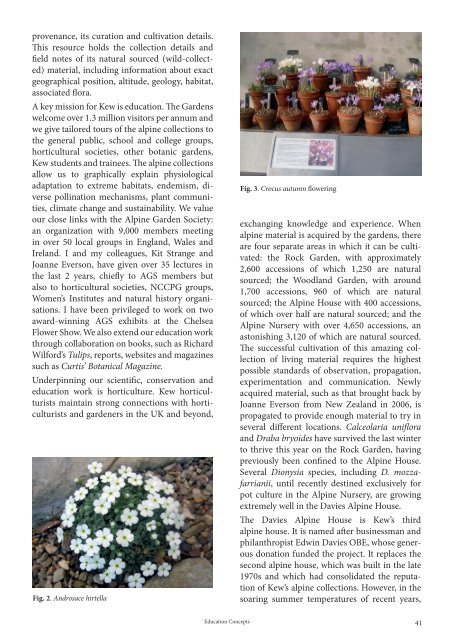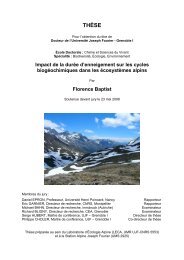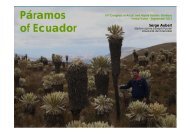2nd International Congress of Alpine and Arctic Botanical Gardens
2nd International Congress of Alpine and Arctic Botanical Gardens
2nd International Congress of Alpine and Arctic Botanical Gardens
You also want an ePaper? Increase the reach of your titles
YUMPU automatically turns print PDFs into web optimized ePapers that Google loves.
provenance, its curation <strong>and</strong> cultivation details.<br />
This resource holds the collection details <strong>and</strong><br />
field notes <strong>of</strong> its natural sourced (wild-collected)<br />
material, including information about exact<br />
geographical position, altitude, geology, habitat,<br />
associated flora.<br />
A key mission for Kew is education. The <strong>Gardens</strong><br />
welcome over 1.3 million visitors per annum <strong>and</strong><br />
we give tailored tours <strong>of</strong> the alpine collections to<br />
the general public, school <strong>and</strong> college groups,<br />
horticultural societies, other botanic gardens,<br />
Kew students <strong>and</strong> trainees. The alpine collections<br />
allow us to graphically explain physiological<br />
adaptation to extreme habitats, endemism, diverse<br />
pollination mechanisms, plant communities,<br />
climate change <strong>and</strong> sustainability. We value<br />
our close links with the <strong>Alpine</strong> Garden Society:<br />
an organization with 9,000 members meeting<br />
in over 50 local groups in Engl<strong>and</strong>, Wales <strong>and</strong><br />
Irel<strong>and</strong>. I <strong>and</strong> my colleagues, Kit Strange <strong>and</strong><br />
Joanne Everson, have given over 35 lectures in<br />
the last 2 years, chiefly to AGS members but<br />
also to horticultural societies, NCCPG groups,<br />
Women’s Institutes <strong>and</strong> natural history organisations.<br />
I have been privileged to work on two<br />
award-winning AGS exhibits at the Chelsea<br />
Flower Show. We also extend our education work<br />
through collaboration on books, such as Richard<br />
Wilford’s Tulips, reports, websites <strong>and</strong> magazines<br />
such as Curtis’ <strong>Botanical</strong> Magazine.<br />
Underpinning our scientific, conservation <strong>and</strong><br />
education work is horticulture. Kew horticulturists<br />
maintain strong connections with horticulturists<br />
<strong>and</strong> gardeners in the UK <strong>and</strong> beyond,<br />
Fig. 2. Androsace hirtella<br />
Fig. 3. Crocus autumn flowering<br />
exchanging knowledge <strong>and</strong> experience. When<br />
alpine material is acquired by the gardens, there<br />
are four separate areas in which it can be cultivated:<br />
the Rock Garden, with approximately<br />
2,600 accessions <strong>of</strong> which 1,250 are natural<br />
sourced; the Woodl<strong>and</strong> Garden, with around<br />
1,700 accessions, 960 <strong>of</strong> which are natural<br />
sourced; the <strong>Alpine</strong> House with 400 accessions,<br />
<strong>of</strong> which over half are natural sourced; <strong>and</strong> the<br />
<strong>Alpine</strong> Nursery with over 4,650 accessions, an<br />
astonishing 3,120 <strong>of</strong> which are natural sourced.<br />
The successful cultivation <strong>of</strong> this amazing collection<br />
<strong>of</strong> living material requires the highest<br />
possible st<strong>and</strong>ards <strong>of</strong> observation, propagation,<br />
experimentation <strong>and</strong> communication. Newly<br />
acquired material, such as that brought back by<br />
Joanne Everson from New Zeal<strong>and</strong> in 2006, is<br />
propagated to provide enough material to try in<br />
several different locations. Calceolaria uniflora<br />
<strong>and</strong> Draba bryoides have survived the last winter<br />
to thrive this year on the Rock Garden, having<br />
previously been confined to the <strong>Alpine</strong> House.<br />
Several Dionysia species, including D. mozzafarrianii,<br />
until recently destined exclusively for<br />
pot culture in the <strong>Alpine</strong> Nursery, are growing<br />
extremely well in the Davies <strong>Alpine</strong> House.<br />
The Davies <strong>Alpine</strong> House is Kew’s third<br />
alpine house. It is named after businessman <strong>and</strong><br />
philanthropist Edwin Davies OBE, whose generous<br />
donation funded the project. It replaces the<br />
second alpine house, which was built in the late<br />
1970s <strong>and</strong> which had consolidated the reputation<br />
<strong>of</strong> Kew’s alpine collections. However, in the<br />
soaring summer temperatures <strong>of</strong> recent years,<br />
Education Concepts 41




